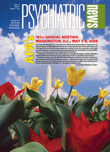Most of the monuments and museums scattered about the nation's capital celebrate heroism and human achievement. But there is one memorial not far from the National Mall that is a solemn reminder of one of humanity's darkest chapters. Since it opened in 1993, millions have come to the United States Holocaust Memorial Museum and found something unlike any other monument or memorial they are likely to see in Washington or many other places.
“Less a museum than a drama in the classical Greek sense” is how it was described by psychiatrist Willard Gaylin, M.D., in an interview with Psychiatric News nearly 15 years ago, just after the museum opened (Psychiatric News, May 21, 1993). Gaylin, a psychoanalyst and a co-founder of the Hastings Center, was one of several psychiatrists who were consulted by designers of the museum.
(He continues to serve as an ex officio member of the Hastings Center board of directors. The Hastings Center is an independent, nonpartisan, nonprofit bioethics research institute formed in 1969 to explore fundamental and emerging questions in medicine, health care, and technology.)
“A profoundly religious experience” is how another psychiatrist, Robert Emde, M.D., described the museum. Emde, who also consulted with designers, is now retired from the Department of Psychiatry at the University of Colorado Health Sciences Center.
Through the years the museum has continued to awe visitors—about 25 million to date.
The permanent exhibition, “The Holocaust,” takes up three floors of the museum and presents a narrative history of the Nazi genocide with more than 900 artifacts, 70 video monitors, and theaters that include historic film footage and eyewitness testimonies. The exhibition is divided into three parts: “Nazi Assault,” “Final Solution,” and “Last Chapter.”
In May, when APA members are in Washington, D.C., for the annual meeting, there will be two special exhibits. One is “Nazi Olympics: Berlin 1936,” about the Olympic Games that were hosted by Hitler's Germany. And“ A Dangerous Lie: The Protocols of the Elders of Zion” explores the impact of the most widely distributed anti-Semitic publication of modern times.
Recently the museum acquired a donation of an album of photographs of Auschwitz concentration camp leaders believed to have been compiled by SS-Obersturmführer Karl Höcker, the adjutant to the commandant of Auschwitz. The album can be seen by the public in the exhibit “Auschwitz Through the Lens of the SS: Photos of Nazi Leadership at the Camp.”
Höcker was stationed at Auschwitz from May 1944 until the evacuation of the camp in January 1945. The photographs depict Höcker with other SS officers in the summer and fall of 1944—the period when the Hungarian Jews arrived and during the last months before the evacuation of the camp.
The photographs offer a chilling look at the death-camp leaders relaxing and socializing in formal and informal settings at a time when the gas chambers were operating at maximum efficiency.
Most first-time visitors spend an average of two to three hours in this self-guided exhibit.
To visit the permanent exhibit, visitors must obtain a free, timed pass on the day of their visit or in advance for a small charge by phone at (800) 400-9373 or online at<www.tickets.com>. The museum distributes a large but limited number of timed entry passes for same-day use on a first-come, first-served basis. Visitors are advised to allow extra time to pass through the building entry line, which can be long during the spring and summer.
In May the building opens at 10 a.m. and closes at 6:30 p.m. It is located at 100 Raoul Wallenberg Place, S.W., in Washington, D.C.
More information is available by phone at (202) 488–0400 or online at<www.ushmm.org>.▪
